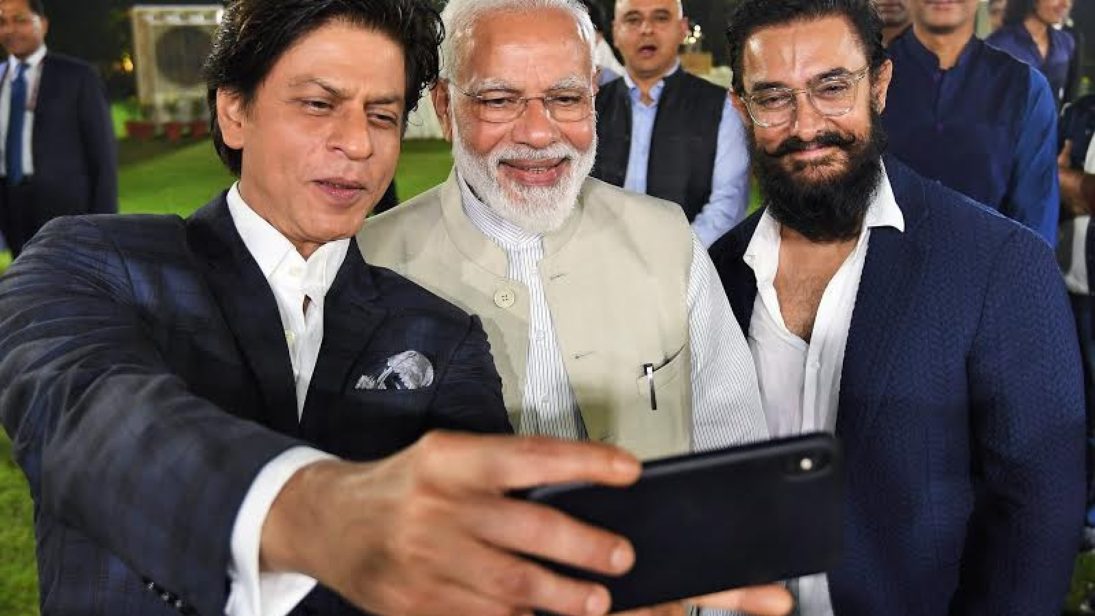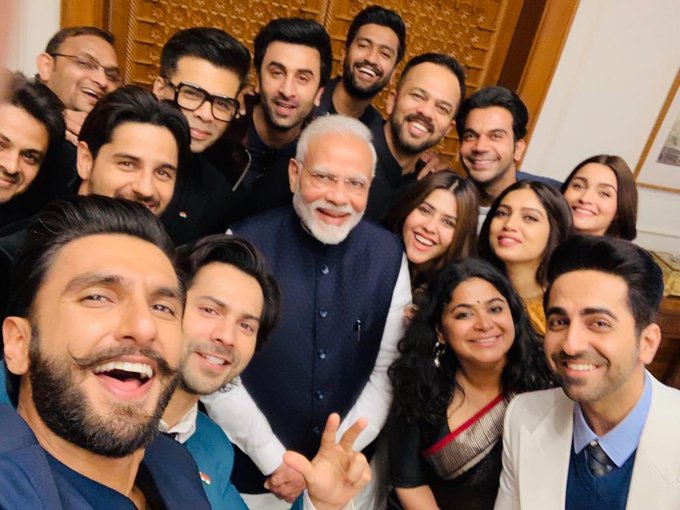
Bollywood in the Time of COVID-19
As India has responded to COVID-19, Indian public figures, particularly celebrities from Bollywood, the globalized Hindi-language film industry, have been key in raising awareness of the disease and supporting lockdown measures. So far, stars have released short films and informational videos, launched aid initiatives, and written inspirational anthems. On April 6, popular actor Akshay Kumar added to this repertoire by producing and releasing an original song for COVID-19 relief, “Muskurayega India” (“India Will Smile”), with an accompanying music video featuring a coterie of popular celebrities.
Unlike other COVID-19 initiatives Bollywood has undertaken so far, however, “Muskurayega India” explicitly aligns its message and aims with Prime Minister Narendra Modi himself. The music video opens with a clip of one of Modi’s addresses to the nation, dietetically presenting Modi as India’s wellspring of inspiration and strength, and closes with a message assuring that proceeds of the song will go to Modi’s new PM-CARES relief fund and the Chief Minister’s Relief Fund. As Akshay Kumar has made his closeness with Modi’s Bharatiya Janata Party (BJP) and Modi himself a major part of his public persona, the endeavor’s Modi-centricity is perhaps unsurprising. However, as ventures like “Muskurayega India” garner attention and praise from the highest echelons of political power, it is important to think critically about the Hindi film industry’s relationship to the central government.
After all, Bollywood, the popular national film industry, has long been considered both a mirror reflecting and a mouthpiece informing the ways in which Indian national imaginaries are bound, and serves as a formidable vehicle for Indian cultural diplomacy and soft power. This makes the Hindi film industry an important focal point for analyzing popular Indian politics and sociopolitical and cultural attitudes. To that end, commentators and analysts have increasingly posed questions about Bollywood’s seemingly pointed silence about, complicity in supporting, and willingness to return the embrace of the central government and Modi himself. In the midst of an already tumultuous year for India, analyzing this complex relationship can help better understand how the Modi government seeks political and ideological legitimacy, and how it may approach governance and influence in a post-COVID-19 world.
Bollywood During Modi’s First Term
In the midst of an already tumultuous year for India, analyzing the government’s relationship with Bollywood can help us better understand how the Modi government seeks political and ideological legitimacy, and how it may approach governance and influence in a post-COVID-19 world.
Since its first electoral victory in 2014, the Modi administration has done its utmost to cultivate a close relationship with the Hindi film industry (though emphatically not with the popular film industries of South India). Bollywood films implicitly and explicitly supporting the government’s programs — including the Swachh Bharat Mission, the Skill India campaign, and even the infamously disastrous demonetization campaign — trickled into theaters throughout Modi’s first term. While the end goals of some of these social programs would contribute to India’s socioeconomic progress, these films exemplify how thoroughly Bollywood seemed to embrace the BJP government’s particular vision of that progress.
What prompted such an unambiguously positive stance? In short: the need to appeal to increasingly polarized Indian public audiences, and to a government that pays a great deal of attention to Bollywood. When leading actors spoke up against rising anti-Muslim sentiment in India, fanned by the Hindu right, they became targets of extreme backlash from BJP party members and supporters, which negatively impacted their box office returns and brand endorsements for years afterwards. These and other incidents — most notoriously, the Hindu-right-supported public agitations against films that featured Pakistani actors in the weeks after the 2016 Uri terrorist attack — solidified for Bollywood the potential costs, financial and otherwise, of being perceived as having acted against the nation. As such, the industry moved to avoid further upsetting the central government, its allies, and its many supporters by producing films that supported BJP programs, as mentioned above; and, less visibly, members of the film industry increasingly began to censor themselves on political issues, on- and off-screen.
These strategic choices culminated in a flurry of films prior to the 2019 elections that tacitly and explicitly supported the BJP, including films about the Indian army’s 2016 surgical strike against Pakistan, and a Modi biopic that the Election Commission of India called a “hagiography.” This period also saw a series of conspicuously staged meetings between the prime minister and delegations from the film industry about “what the entertainment industry in India can contribute as a soft power of the nation around the world.” While these meetings may have netted it useful gains, Bollywood’s increasingly formal yielding of its agency to the government effectively turned the so-called national film industry into a soft-power mouthpiece for the central government.

Bollywood Under Modi 2.0
The aggressive domestic moves that have characterized Modi’s second term seemed to solidify Bollywood’s deferential relationship with the BJP. For example, after the surprise revocation of Articles 370 and 35A from Jammu and Kashmir on August 5, 2019, Modi implored filmmakers to return to the Kashmir Valley, to economically integrate and imaginatively reclaim the erstwhile state. While this return has yet to occur, several major actors and producers came out in favor of the controversial decision, and producers rushed to register Kashmir-related titles for future films.
However, the introduction of the allegedly anti-Muslim Citizenship Amendment Act (CAA) in the Indian Parliament at the end of the year and the brutal retaliation against students and protesters seemed to open the floodgates for new, urgent readings of the central government’s policies across the country, even within the film industry. Most notably, on January 7, actress Deepika Padukone attended a protest by students at Jawaharlal Nehru University (JNU), who had been attacked by an RSS-affiliated mob. Padukone’s unambiguous stand, two years after her own brush with Hindu right-fanned violence (which saw BJP officials announce a reward for her beheading) catalyzed an unprecedented outpouring of support from other celebrities for the students and anti-CAA protesters. At the same time, the BJP’s own attempts to entice major Bollywood stars to support the CAA failed miserably. These instances inspired some hope that the anti-CAA movement would herald the awakening of a more critical, politically-engaged film industry.
The aggressive domestic moves that have characterized Modi’s second term seemed to solidify Bollywood’s deferential relationship with the BJP.
Subsequent developments in 2020 have thus far undermined that possibility. First, the 2020 Filmfare Awards ceremony were held outside of Mumbai for the first time in its history — specifically, in Guwahati, the largest city in Assam. This move raised suspicions that the awards show was intended to distract from that state’s particularly strident protests against the CAA and the National Registry of Citizens (NRC). Following the February 23 outbreak of communal riots in Delhi, celebrities once again expressed shock at the violence. These statements could not compete, in terms of scale and audience, with the anti-CAA protests and did not alter the way in which the riots were popularly perceived. This trend suggests that the momentum for a potential political reawakening in Bollywood had already slowed by the time that COVID-19 response measures took hold in India.
Implications for Post-Pandemic Indian Society and Politics
If Bollywood can both reflect and shape Indian public opinion and discourse, then the film industry’s increasing support of Modi’s COVID-19 response may be understood — at the expense of the activist momentum it had garnered during the anti-CAA protests earlier in 2020 — as a bellwether for Indian society in the first weeks of the lockdown. With celebrities across India lining up to support Modi’s solidarity initiatives like the initial Janta Curfew, 9-minute vigil, and the PM-CARES fund, the scale of the pandemic response has already shrunk the space for Bollywood and even the typically more politically engaged Southern film industries to engage critically on extant political and domestic issues.
More specifically, one can look to “Muskurayega India’s” deliberate balancing of Bollywood’s briefly-reawakened political voice and its role in assisting the pandemic response as an instructive example of what may lie ahead. This filmi endeavor gestures towards contributing to the national public good, but only on the terms already set by the BJP; namely, it places Prime Minister Modi himself at the heart of India’s national public good in the first place. This approach maximizes Bollywood’s appeal to India’s polarized public, and also builds in an element of plausible deniability for the celebrities themselves regarding their cooperation with the state.
The all-India COVID-19 response could well be the most complicated vector yet through which the Modi government legitimizes its power and exercises its influence over Indian society. Although commentators pointed towards a potentially seismic shift in Bollywood’s relationship with the Modi government earlier this year, the current state of that relationship — most recently marked with a new Information and Broadcasting Ministry requirement for entertainment streaming services to censor their content — no longer bears out that expectation. In a time of immense economic, political, and social flux in India, particularly in the time of COVID-19, Bollywood may not be able to completely disentangle itself from the auspices of the Modi government. Indeed, it may not feel a strong enough incentive to do so. Nonetheless, in the words of superstar actor Shahrukh Khan, picture abhi baaki hai: the film is not yet over. And when it comes to the relationship between Bollywood and the BJP, there may as yet be many twists and turns in the story.
***
Image 1: Narendra Modi via Twitter
Image 2: Karan Johar via Twitter


